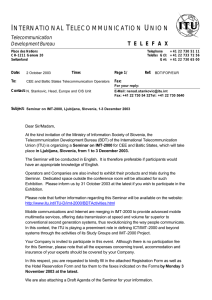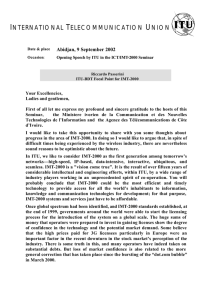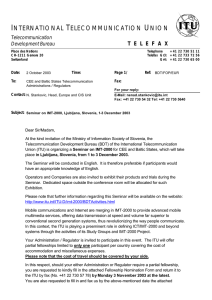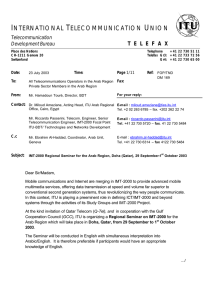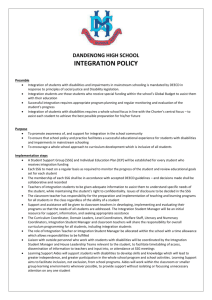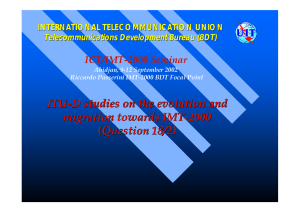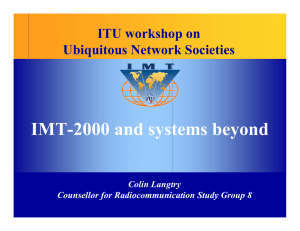ITU-T SSG: “IMT-2000 and Beyond” Abidjan, Côte d’Ivoire 9-12 September 2002
advertisement
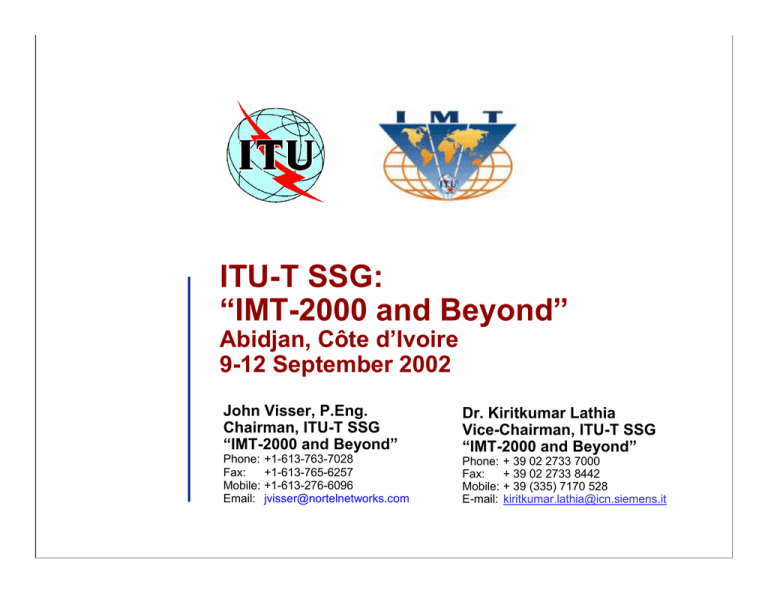
ITU-T SSG: “IMT-2000 and Beyond” Abidjan, Côte d’Ivoire 9-12 September 2002 John Visser, P.Eng. Chairman, ITU-T SSG “IMT-2000 and Beyond” Phone: Fax: Mobile: Email: +1-613-763-7028 +1-613-765-6257 +1-613-276-6096 jvisser@nortelnetworks.com Dr. Kiritkumar Lathia Vice-Chairman, ITU-T SSG “IMT-2000 and Beyond” Phone: Fax: Mobile: E-mail: + 39 02 2733 7000 + 39 02 2733 8442 + 39 (335) 7170 528 kiritkumar.lathia@icn.siemens.it Objective and Outline • Objective: – provide overview of ITU-T SSG activities on “IMT-2000 and Beyond” • Outline: – – – – – Brief historical review: why create the SSG SSG Mandate SSG Work structure Results so far Going forward • Referencing • OHG, 3GPPs and Harmonization • Vision beyond IMT-2000 – Summary Special Study Group on IMT-2000 and Beyond 3 September 2002 - 1 Dramatic Growth Forecast for Worldwide 3G Revenues Data Subscriber Growth Data Traffic Growth Applications Growth Subscriber Growth “Realistically Forecasting 3G Users and Revenues” Paola Tonelli, UMTS Forum Operators’ Group Chairperson UMTS 2001, Barcelona, 17 October, 2001 http://www.umts-forum.org Special Study Group on IMT-2000 and Beyond 3 September 2002 - 2 Revised forecasts with industry downturn “The continuing economic downturn and the catastrophic events of September 11th last year have given rise to concerns about the viability of mobile data services and in particular 3G. These concerns have been exacerbated by the slowdown in subscriber growth and the announcements by many operators of reduced capital expenditures. These developments have prompted The UMTS Forum to re-examine its 3G market forecasts published in August 2001. The results appear in the Forum’s Report No 18. The conclusion of this report is that there is no necessity to revise growth figures projected in the August 2001 report, which, in any event, were built on an assumption of slow adoption for the first five years of 3G availability.” Source: MobilleniuM, June 2002 ( http://www.umts-forum.org/mobilennium_online/2002.06/index.html ) Special Study Group on IMT-2000 and Beyond 3 September 2002 - 3 Why is this Study Group special? • Given significant freedom in conducting its business: – – – – – – Paperless meetings to maximum extent possible Reduced meeting notice requirements Reduced contribution submission deadline All documents made available on ITU web site Formal meeting reports made available quickly Use of e-meetings, teleconferences, other means to conduct work • Plus has the usual powers of a Study Group: – Create and approve Recommendations • Must report to TSAG regularly: – On progress of work, and on effectiveness of new procedures and working methods Special Study Group on IMT-2000 and Beyond 3 September 2002 - 4 Why is this Study Group special? • Management Team – Larger than usual – Strength in diversity: • viewpoints from vendors, operators and regulators • viewpoints from developed and developing countries Special Study Group on IMT-2000 and Beyond 3 September 2002 - 5 Summary of SSG Mandate • Lead SG on IMT-2000 and beyond and for mobility – Primary responsibility within ITU-T for overall network aspects of IMT-2000 and beyond • To study: – – – – Vision for IMT-2000 and Beyond (circa 2010) Identification and globalization of IMT-2000 Family members Support harmonization of evolving IMT-2000 Family members Convergence of fixed and wireless networks • To assist developing countries in applying IMT-2000 • Emphasis on strong cooperative relations and complementary programs with SDOs, 3GPPs • Make use of provisional working procedures specific to SSG: • Recommendation A.9: Provisional working procedures for SSG Special Study Group on IMT-2000 and Beyond 3 September 2002 - 6 IMT-2000 Standards: a Global Partnership IMT-2000 ITU-T SSG GSM- based UMTS ITU-R WP 8F ARIB /TTC T1P1 Mobile IP TTA TIA IS-41 + CDMA2000 + M-IP Architecture Special Study Group on IMT-2000 and Beyond 3 September 2002 - 7 SSG Approach Revolution from IP infrastructure EMPHASIS ON: IP • Collaboration • Cooperation 2G Evolution from 2G systems 3G and Beyond • Partnering BUT NOT: • Duplication of work Special Study Group on IMT-2000 and Beyond Revolution from subscriber service expectations 3 September 2002 - 8 SSG Mandate translated into Study Questions • Q.1/SSG Service and network capability requirements and network architecture (“Vision”) • Q.2/SSG NNI mobility management protocol • Q.3/SSG Identification of existing and evolving IMT-2000 Systems (“ID Systems”) • Q.4/SSG Interworking functions to be used with existing and evolving IMT-2000 systems • Q.5/SSG Preparation of a Handbook on IMT-2000 (“Handbook”) • Q.6/SSG Harmonisation of existing IMT-2000 Systems • Q.7/SSG Convergence of fixed and existing IMT-2000 systems (“Convergence”) • Q.8/SSG Special Study Group working procedures (“Procedures”) Question details are available at: http://www.itu.int/ITU-T/studygroups/ssg/questions.html Special Study Group on IMT-2000 and Beyond 3 September 2002 - 9 SSG Work Topics and Relationships SSG WP 2/SSG WP 1/SSG WP 3/SSG Q.2, Q.4 & Q.6/SSG Interworking & Harmonization For consideration by: Q.1/SSG Vision Operator Operator Inputs Inputs Q.3/SSG ID Systems Q.7/SSG Convergence Q.5/SSG Handbook Q.8/SSG Procedures Special Study Group on IMT-2000 and Beyond 3 September 2002 - 10 Q.1/SSG: “Vision” – Key results to date • Closely coupled with ITU-R WP 8F efforts towards their PDNR IMT.VIS – SSG represented at WP 8F meetings, vice versa – Working together to ensure consistency between Radio and Core Network views: describe a single, common ITU “Vision” – Recommendation Q.1702 (“Long-Term Vision of Network Aspects for Systems Beyond IMT-2000”) approved 4 July 2002 SSG and beyond WP 8F Special Study Group on IMT-2000 and Beyond 3 September 2002 - 11 Defining the Vision: Capabilities of IMT-2000 and Systems Beyond Systems Beyond IMT-2000 will encompass the capabilities of previous systems Mobility New Capabilities Of Systems Beyond IMT-2000 High IMT-2000 Enhanced IMT-2000 New Mobile Access Dashed line indicates that the exact data rates associated with Systems Beyond are not yet determined. Enhancement New Nomadic / Local Area Wireless Access Low 1 KEY: 10 100 Peak Useful Data Rate (Mb/s) 1000 denotes interconnection between systems via networks or the like, which allows From ITU-R Doc. 8F/728-E, Report of the 8th Meeting - Ottawa, 29 May 5 June 2002 flexible use in any environments without making users aware of constituent systems. Nomadic / Local Area Access Systems Digital Broadcast Systems Dark gray color indicates existing capabilities, medium gray color indicates enhancements to IMT-2000, and the lighter gray color indicates new capabilities of Systems Beyond IMT-2000. The degree of mobility as used in this figure is described as follows: Low mobility covers pedestrian speed, and high mobility covers high speed on highways or fast trains (60 km/h to ~250 km/h, or more). Special Study Group on IMT-2000 and Beyond Illustration of Capabilities of IMT-2000 and Systems Beyond 3 September 2002 - 12 Defining the Vision: Complementary Access Systems Distribution Layer • full coverage • global access • full mobility • not necessarily individual links Cellular Layer • full coverage and "hot spots" • global roaming • full mobility • individual links • local coverage • "hot spots" • global roaming • local mobility • individual links Hot Spot" Layer • short range communication • global roaming • individual links Personal Network Layer Fixed (Wired) Layer X X X X X X X X X X X X X X X From ITU-R Doc. 8F/728-E, Report of the 8th Meeting - Ottawa, 29 May 5 June 2002 • no mobility • global roaming • individual links horizontal: handover within a system Possible return channels vertical: handover between systems •Figure 4-5: Illustration of complementary access systems Special Study Group on IMT-2000 and Beyond 3 September 2002 - 13 Q.2, 4, 6, 7/SSG: Interworking, Harmonization, Convergence • Acting as a catalyst and facilitator toward global roaming, service and network interoperability – Promote adoption of common approaches – Identify differences, identify candidate solutions if available, interact with regional bodies to facilitate agreements – Regional bodies remain in full control: may choose to act or not based on own decision processes as supported by membership • Supporting OHG initiative toward a common IP Core Network approach – Operator involvement and support essential to drive agreements and achieve success • Deliverable outlines and initial drafts available, work progressing Special Study Group on IMT-2000 and Beyond 3 September 2002 - 14 OHG All IP Core Network Harmonization • Toronto, 3-4 Apr 2002 • Participants expressed desire for: – Common SIP based Call/Session control protocol to enable interoperability between 3GPP and 3GPP2 networks – Common approaches for SIP enhancements in IETF including collaborations on proposals to IETF – Common Application Programming Interfaces (APIs) – Common SIP based Services to enable interoperability between 3GPP and 3GPP2 networks – Common approaches to new IP-multimedia services Special Study Group on IMT-2000 and Beyond 3 September 2002 - 15 3GPP & 3GPP2 All IP Core Network Harmonization Agreements • Harmonization of 3GPP and 3GPP2 IP Multimedia Core Networks is worthwhile and achievable – this goal should be pursued urgently by both PPs • Focus harmonization efforts where synergies already exist: – OSA/PARLAY based service APIs – IMS (3GPP IP Multimedia Subsystem and equivalent in 3GPP2 MMD) • Agreed that 3GPP and 3GPP2 should adopt: – a single IMS reference model – consistent terminology to describe common IMS functional entities • 3GPP and 3GPP2 should work to ensure: – interoperability between the 3GPP IMS mobiles and 3GPP2 IMS mobiles (a 3GPP IMS mobile can set up a session with a 3GPP2 IMS mobile and viceversa) – application level intersystem IMS roaming (given that the mobile supports the visited network’s access network and IP transport technology, a 3GPP IMS mobile should be able to roam into a 3GPP2 network and vice-versa) Special Study Group on IMT-2000 and Beyond 3 September 2002 - 16 All IP Core Network Workshop documents: www.3gpp.org - /ftp/tsg_cn/Joint_Meetings/IP_CN_Workshop/ [To Parent Directory] 4/4/02 9:47 PM 3/20/02 8:58 AM 3/20/02 8:58 AM 3/20/02 8:58 AM ............ 4/4/02 9:52 PM 4/4/02 9:57 PM 4/4/02 9:57 PM 4/4/02 9:58 PM 4/4/02 9:58 PM 4/4/02 9:58 PM 69632 12172 33657 15380 578846 1003847 3434 26948 33269 22528 IP CN Harm Workshop Agenda rev 11.doc IP_CN_2002_001_Agenda.zip IP_CN_2002_002.zip IP_CN_2002_003.zip #043: #043:Workshop Workshop Recommendations Recommendations IP_CN_2002_040.zip IP_CN_2002_041.zip IP_CN_2002_042.zip IP_CN_2002_043.zip IP_CN_2002_044.zip IP_CN_2002_Tdoc_list.xls #044: #044:Meeting Meeting Summary Summary Document Document List List Special Study Group on IMT-2000 and Beyond 3 September 2002 - 17 Q.3/SSG: “ID IMT-2000 Systems” – Key results to date • Q.1741.1 (Rel. 99) approved April 2002 • Q.1741.2 (Rel. 4) on track for approval 4Q2002 • Q.1742.1: on track for approval 4Q2002 Special Study Group on IMT-2000 and Beyond 3 September 2002 - 18 Q.5/SSG: “Handbook” Key results to date • Outline in place, substantive inputs received • First significant editing sessions in 20-27 May 2002 (SSG) and 29 May – 5 June 2002 (WP 8F) • Editing meeting 18-19 September 2002 • Target for approval in 4Q2002 • ITU-R • ITU-T • ITU-D Special Study Group on IMT-2000 and Beyond 3 September 2002 - 19 Q.8/SSG: “Procedures” results to date • Enhanced Recommendation A.9 substantially finalized in May 2002 SSG meeting – bottom-up approach on selected ITU reform aspects – e-meeting guidelines, other aspects, based on practical experience • Included proposal on Technical Specifications: – must be high quality, do not require unanimity, limited lifetime – but no consensus: sought TSAG guidance • Proposed revised Rec. A.9 passed to TSAG June 2002 – no consensus in TSAG on Technical Specifications • PP-02 topic? Special Study Group on IMT-2000 and Beyond 3 September 2002 - 20 Summary • Meeting end user needs such that everyone wins is the essential driver for operators and vendors – Global roaming, seamless service delivery, network interoperability • Dealing with heterogeneity is fundamental to success – Evolution from and interworking with 2G and 3G systems and beyond • Consistency in APIs will allow the infrastructure to evolve without rendering services obsolete • 3GPPs and ITU provide complementary near, medium and long term perspectives • ITU-T SSG and ITU-R WP 8F add an essential global perspective to regional standards activities Special Study Group on IMT-2000 and Beyond 3 September 2002 - 21 SSG adds value in global standards for “IMT-2000 and Beyond” • Leadership through coordination, consensus building, and collaborative working arrangements • Facilitating adoption of appropriate external specifications as ITU-T Recommendations – act as a single source for IMT-2000 and related standards • Development of requirements and architectural framework Recommendations as appropriate • Identifying emerging industry needs for global standards • Facilitating interoperability and interworking between IMT-2000 family members for global roaming, seamless service delivery Special Study Group on IMT-2000 and Beyond 3 September 2002 - 22 IMT-2000 and Beyond... Global Satellite Suburban Macrocell Urban Microcell In-Building Picocell Basic Terminal PDA Terminal Audio/Visual Terminal Realizing the Vision will require a well-coordinated global effort. Special Study Group on IMT-2000 and Beyond 3 September 2002 - 23 Selected Acronyms 3G 3GPP 3GPP2 AAP APT ARIB CDMA CPM CWTS DECT ETSI GSA GSM IETF Third Generation Third Generation Partnership Project Third Generation Partnership Project 2 Alternate Approval Process Asia-Pacific Telecommunications Association of Radio Industries and Businesses (Japan) Code Division Multiple Access Conference Preparatory Meeting (for WRC) China Wireless Telecommunications Standard Digital European Cordless Telephone European Telecommunications Standards Institute Global mobile Suppliers Association Global System for Mobility Internet Engineering Task Force Special Study Group on IMT-2000 and Beyond IMS IMT-2000 IP IS-41 ITU ITU-D ITU-R ITU-T LAN M-IP MWIF OAM OHG OSA PDA PDNR PLMN PSTN IP Multimedia Subsystem International Mobile Telecommunications Internet Protocol TIA Interim Standards-41 International Telecommunications Union ITU Development Sector ITU Radio Sector ITU Telecommunication Sector Local Area Network Mobile Internet Protocol Mobile Wireless Internet Forum Operations, Administration and Maintenance Operator Harmonization Group Open Services Architecture Personal Digital Assistant Proposed Draft New Recommendation Public Land Mobile Network Public Switched Telephone Network SDO SG SIP SSG TIA TSAG TTA TTC UMTS UWCC WP WRC WTSA Standards Development Organization Study Group Session Initiation Protocol Special Study Group Telecommunications Industry Association ITU-T Telecommunications Standards Advisory Group Telecommunications Technology Association (Korea) Telecommunication Technology Committee (Japan) Universal Mobile Telecommunication System Universal Wireless Communications Consortium Working Party ITU-R World Radio Conference ITU-T World Telecommunications Standardization Assembly 3 September 2002 - 24
